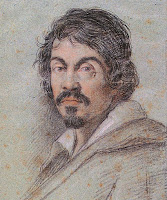Supper at Emmaus
In the middle of the afternoon, a man runs frantically on
the shore under the fierce summer sun. He is desperate to get to Rome and is
trying to catch a glimpse of the boat that has left with all his belongings. He
is a murderer, a fugitive, has an infected sword wound, and a raging fever, he
is also the most powerful and influential Italian painter of that time.
Michelangelo Merisi da Caravaggio died on the 18th of July 1610 at the young age of 38,
alone and penniless on a hospital bed in Ponto Ercole.
Caravaggio was born
in Milan in 1571. He moved to Rome in his early twenties, arrogant and
rebellious, Caravaggio was a violent man in a violent world. Rome in the late
sixteenth and early seventeenth century was a difficult place to say the least.
Thousands of artists flocked to the city in search of work. The Vatican was a
magnet for artists, and each one was competing for powerful patrons in the
church .There were no rules and hostilities ran deep. It’s against this backdrop
that Caravaggio managed to establish himself as the most famous artist in Rome.
It was during this time that he met Ciriaco Mattei. He was an Italian nobleman
of Rome and belonged to one of the most powerful and influential families
during this period, they held high positions in the church and the government.
Mattei, who was a prolific art collector of his time, became a close friend and
patron of Caravaggio.
At the height of Caravaggio’s career in 1601, Ciriaco Mattei
commissioned him to paint what is widely considered to be one of his most powerful
paintings, ‘Supper at Emmaus’.
As the story goes, after Christ’s crucifixion, two of his
disciples were walking to a small town near Jerusalem called Emmaus, when they
met a man who joined them and agreed to have dinner with them. The disciples did not know at that time that
this third man was in fact the resurrected Christ, he was incognito and so they
failed to recognize him.
The painting captures that culminating moment in the
narrative when Christ blesses the bread at supper and then vanishes, the
disciples realize that this is the risen Christ, it’s the moment of spiritual
as well as physical recognition, the moment when the divine enters the everyday
world. Painted in oil and tempera on canvas, this 141 x 196.2 cm painting is
full of drama. The use light plays a very essential role and underlines the main
message of the painting, Caravaggio is
known for his strong use of light and shade known as, 'Chiaroscuro' to add that
element of drama and theatre in his paintings. He always used live models, as a
result his figures are very real, they’re normal folk they are poor, dirty and
their hands are rough.

We can see the disciple in the torn green shirt, literally jumping up in his chair in that moment; his elbow is jutting out breaking into the viewer’s space. The second disciple has his arm spread out in surprise, he seems to be inviting the viewer to come and share this great moment with them.
There is space at the table for the viewer making us a participant in this great event.

Christ’s face is bathed in light, the innkeeper on the other hand, standing in the background remains in the dark, his face in shadow. He hasn’t realised the significance of the moment, he hasn’t seen the 'light'.
 The dinner on the
table consists of bread, fowl and a basket of fruit. The food here is symbolic, the fowl is
mirroring death, the bread is Christ’s flesh and the grapes in the basket make
wine, a symbol of his blood. The fruit in the basket looks so realistic, you
feel it’s good enough to eat. The basket itself is precariously placed at the
edge of the table, almost asking the viewer to push it back. This is another
way in which Caravaggio manages to include us in this great event.
The dinner on the
table consists of bread, fowl and a basket of fruit. The food here is symbolic, the fowl is
mirroring death, the bread is Christ’s flesh and the grapes in the basket make
wine, a symbol of his blood. The fruit in the basket looks so realistic, you
feel it’s good enough to eat. The basket itself is precariously placed at the
edge of the table, almost asking the viewer to push it back. This is another
way in which Caravaggio manages to include us in this great event.
Though the painting was criticized by some of his critics
for showing Christ without a beard, Supper at Emmaus, exemplifies religious
history painting. It’s timeless quality reaffirmed Caravaggio's position as
the greatest painter of that time.
Caravaggio’s short and tempestuous life matched the drama of
his paintings. He got into brawls easily and got arrested repeatedly. In 1606, at the age of 34, he got into a fight and killed a man, instead of facing the law he fled Rome,
he went to Naples and then the island of Malta, he finally died trying to make
his way back to his beloved city. Caravaggio’s paintings were controversial,
popular and hugely influential on succeeding generations of painters all over
Europe.
Today ‘Supper at Emmaus’ can be seen in The National Gallery in
London. Caravaggio painted a second version of this painting about five years
after the first one, it can be seen in Pinacoteca di Brera, Milan.
References:
References:
Andrew Graham Dixon,
Smart History




Comments
Post a Comment